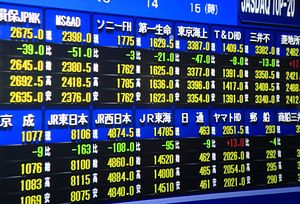Despite sluggish economic indicators such as a declining GDP and shrinking inflation following last April’s consumption tax increase, the government of Japan is doubling down on some of the key Abenomics policies that saw the country’s economy bounce back at the beginning of Prime Minister Shinzo Abe’s administration. Since this weekend the government has announced a more aggressive investment policy at the Government Pension Investment Fund (GPIF), a new stimulus package, and additional monetary easing. The first of these moves had long been planned, while the second was expected, but the third caught markets off guard. However, all are designed to restart a sluggish economic recovery and give Abe the ability to follow through with the second consumption tax hike, expected in October of next year.
The shift in direction at the conservative GPIF has been expected for most of Abe’s administration, even if the exact changes to its portfolio weren’t clear. However, “informed sources” that spoke with the Jiji Press stated that the GPIF will raise its percentage of Japanese stocks from 12 percent to 25 percent, while domestic bonds will be reduced from 60 percent to 35 percent of its portfolio. Additionally, foreign stocks and bonds will be raised from 12 to 25 percent and 11 to 15 percent respectively. The GPIF currently manages about assets of about 127 trillion yen ($1.18 trillion), and the diversification is seen as a way to better manage the large pension fund’s investments as the country is expected to transition out of deflation.
The new stimulus was also widely expected, even if the government had not made any official mention of one, especially as the economy has stalled since this summer. However, the size and target for the new government spending is worth noting. Government sources that spoke with the Yomiuri Shimbun have said the administration is aware of complaints that past stimulus have been little more than pork barrel spending, funding projects that do not directly contribute to real economic growth beyond the initial flush of spending. In light of these issues, the government says it plans to “focus on such measures as those to address rising fuel costs or to benefit low-income earners,” while “government spending on the measures could reach ¥3 trillion to ¥4 trillion in total.”
This new stimulus reflects the 5.5 trillion yen in additional spending that the government put in place last December before the April tax increase from 3 to 5 percent. With an eye toward the proposed October 2015 increase to 10 percent, the government sources also indicated that there could be a further stimulus sometime in fiscal 2015. For the initial stimulus, however, the only clear indications of what it will be spent on include “subsidies for farming households suffering from rising fuel costs or for companies purchasing energy-saving equipment… and renovation of aging roads bridges and tunnels.”
The final and least expected piece of news concerned the Bank of Japan’s latest announcement of additional monetary easing. After a Policy Board meeting on Friday, BOJ Governor Karuhiko Kuroda told reporters that “We decided to expand our easing regime to ensure that our 2 percent inflation target will be achieved at an early time,” and that “it will conduct money market operations so that the country’s monetary base will increase at an annual pace of ¥80 trillion, up from the previously targeted pace of ¥60 trillion to ¥70 trillion.”
What makes Kuroda’s decision unexpected is that he has been saying over the past few months that he was pleased with the current rate of growth, despite the fact that inflation had cooled from 1.5 percent in April to just 1 percent before the BOJ’s announcement. Additionally, unlike the previous round of monetary easing that passed the Policy Board by a 9-0 vote, last Friday’s vote barely passed 5-4.
The government appears to be firing on all cylinders to keep its fragile economic recovery on track. Weak third quarter growth after the economy contracted 7.1 percent in the second quarter would begin to put significant political pressure on the Abe administration. As a consequence, the prime minister and other government institutions look to be trying to get out in front of the issue with measures intended to reassure markets, voters and consumers. It also appears that the LDP-led government remains focused on keeping the next tax increase in place, as it is conducting hearings on the issue from Tuesday until November 18, after which Abe will “give instructions to compile the economic measures [stimulus].” If the government plans to stick to its original schedule of announcing the tax increase in December, then the next few weeks will be crucial for improving the ability of both public opinion and the economy to absorb it.































